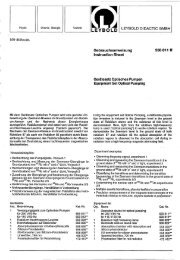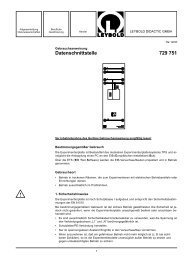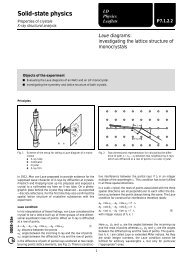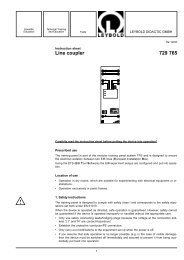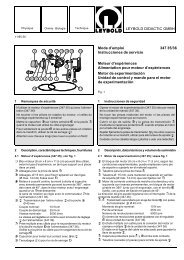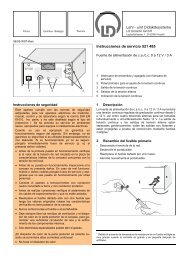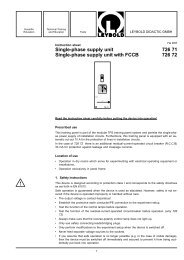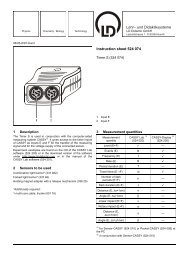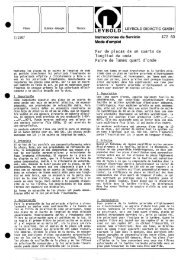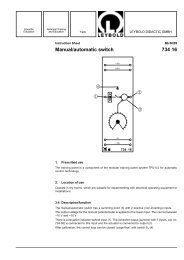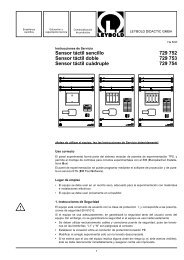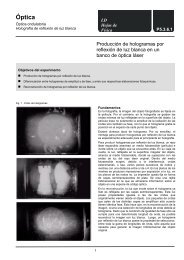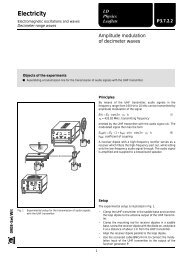Optics - LD DIDACTIC
Optics - LD DIDACTIC
Optics - LD DIDACTIC
Create successful ePaper yourself
Turn your PDF publications into a flip-book with our unique Google optimized e-Paper software.
0206-Sel<br />
<strong>Optics</strong><br />
Polarization<br />
Pockels effect<br />
Objects of the experiment<br />
To identify the optical axis of the birefringent crystal of the Pockels cell in a conoscopic beam path.<br />
To demonstrate the Pockels effect in a conoscopic beam path.<br />
To measure the half-wave voltage of the Pockels cell.<br />
Fig. 1: Schematic diagram of a Pockels cell in transverse configuration<br />
Fig. 2: Diagram of a conoscopic beam path for demonstrating<br />
birefringence<br />
1<br />
<strong>LD</strong><br />
Physics<br />
Leaflets<br />
Demonstrating<br />
the Pockels effect<br />
in a conoscopic beam path<br />
P5.4.5.1<br />
Principles<br />
The Pockels effect<br />
The Pockels effect is the name given to the occurrence of<br />
birefringence and to the change in existing birefringence phenomena<br />
in an electric field linearly proportional to the electric<br />
field strength. It is related to the Kerr effect, although in the<br />
latter case the birefringence increases exponentially with the<br />
electric field strength. For reasons of symmetry, the Pockels<br />
effect can only occur in crystals with no inversion center,<br />
whereas the Kerr effect can occur in all substances.<br />
When the direction of the light beam and the optical axis of<br />
birefringence are perpendicular to each other, we call this a<br />
“transverse configuration” (see Fig. 1). The electric field is<br />
applied in the direction of the optical axis. For Pockels cells in<br />
the transverse configuration, lithium niobate (LiNbO3) is most<br />
often used.<br />
Lithium niobate crystals are optically uniaxial, negatively<br />
birefringent and have the main refractive indexes no = 2.29 for<br />
the ordinary beam, and ne = 2.20 for the extraordinary beam<br />
(measured using the wavelength of the He-Ne laser, � =<br />
632.8 nm.<br />
Birefringence in a conoscopic beam path<br />
The proof of birefringence in a conoscopic beam path is<br />
described in numerous optics textbooks. A crystal with planeparallel<br />
cut faces is illuminated with a divergent, linearly<br />
polarized light beam, and the light passing through it is observed<br />
behind a perpendicularly aligned analyzer (see Fig. 2).<br />
The optical axis of the birefringence is clearly apparent in the<br />
interference image, as it is indicated by the symmetry in its<br />
vicinity. In this experiment, the optical axis is parallel to the<br />
entrance and exit surfaces; this is why the interference pattern<br />
consists of two sets of hyperbolas [1] which are rotated by 90�<br />
with respect to one another. The real axis of the first hyperbola<br />
set is parallel to the optical axis, while that of the second set<br />
is perpendicular to the optical axis.
P5.4.5.1 <strong>LD</strong> Physics Leaflets<br />
Apparatus<br />
1 Pockels cell . . . . . . . . . . . . . . . . . 472 90<br />
1 High-voltage power supply, 10 kV . . . . . 521 70<br />
1 He-Ne laser, linearly polarized . . . . . . . 471 480<br />
1 Lens in holder, f = 5 mm . . . . . . . . . . 460 01<br />
1 Lens in holder, f = 50 mm . . . . . . . . . . 460 02<br />
1 Polarization filter . . . . . . . . . . . from 472 40<br />
1 Optical bench, 1 m, standard cross-section 460 32<br />
5 <strong>Optics</strong> riders, H = 60 mm, W = 36 mm . . . 460 353<br />
1 Translucent screen . . . . . . . . . . . . . 441 53<br />
1 Saddle base . . . . . . . . . . . . . . . . . 300 11<br />
1 Safety connection lead, red . . . . . . . . 500 641<br />
1 Safety connection lead, blue . . . . . . . . 500 642<br />
1 Safety connection lead, 10 cm . . . . . . . 500 604<br />
The dark lines of the interference image are caused by light<br />
rays for which the difference between the optical paths of the<br />
extraordinary and the ordinary partial beam in the crystal is an<br />
integral multiple of the wavelength. These light rays retain their<br />
original linear polarization after passage through the crystal,<br />
and are extinguished in the analyzer. The light rays reaching<br />
the center of the interference image are normally incident on<br />
the surface of the crystal. For these rays, the path difference<br />
between the extraordinary and the ordinary partial beam is<br />
� = d ⋅ (no − ne), (I)<br />
where d = 20 is the thickness of the crystal in the direction of<br />
the beam. The path difference corresponds to approximately<br />
2800 wavelengths of the laser light used. however, � is not<br />
usually precisely a whole multiple of �, but rather lies between<br />
two values, �m = m ⋅ � and �m+1 = (m + 1) ⋅ �. The dark lines<br />
in the first hyperbola set thus correspond to the path differences<br />
�m+1, �m+2, �m+3, etc., and those of the second set to<br />
�m, �m−1, �m−2, etc. (Fig. 3). The position of the dark lines, or<br />
better their distance from the center, depends on the magnitude<br />
of the difference between � and m ⋅ �.<br />
Safety note<br />
The He-Ne laser fulfills the German technical standard<br />
“Safety Requirements for Teaching and Training Equipment<br />
– Laser, DIN 58126, Part 6” for class 2 lasers. When<br />
the precautions described in the Instruction Sheet are<br />
observed, experimenting with the He-Ne laser is not<br />
dangerous.<br />
Never look directly into the direct or reflected laser<br />
beam.<br />
Do not exceed the glare limit (i.e. no observer should<br />
feel dazzled).<br />
2<br />
Fig. 3: Interference pattern in the conoscopic beam path with the<br />
optical axis of the crystal in the direction of the arrow. The<br />
numbers represent the path difference between the ordinary<br />
and the extraordinary partial beam. Thus for example<br />
the lines with the value +1(−1) have the path difference<br />
�m+1 (�m−1)<br />
The Pockels effect magnifies or reduces the difference of the<br />
main refractive indices n o – n e, depending on the sign of the<br />
applied voltage. This in turn alters the difference � – m ⋅ �, and<br />
thus the position of the dark interference lines. If the so-called<br />
half-wave voltage U � is applied, the value of � is changed by<br />
one-half wavelength. The dark interference lines shift to the<br />
positions of the bright lines, and vice versa. This process<br />
repeats itself each time the voltage is increased by U �.<br />
Setup<br />
Notes:<br />
Carry out all measurements in a darkened room.<br />
Do not insert the rods of the optical components all the way in<br />
the optics riders, so that subsequent fine adjustment of the<br />
height can be carried out.<br />
Fig. 4 shows the experiment setup; the position of the left edge<br />
of each optics rider is given in cm.<br />
Setting up the optical components:<br />
– Mount the He-Ne laser, the 5-mm lens (a) and the 50-mm<br />
lens (b). Carefully turn the laser and the 5-mm lens and<br />
adjust their heights so that optimum illumination of the<br />
50-mm lens is achieved.<br />
– Set up the translucent screen at a suitable distance, and<br />
attach a piece of white paper to the screen.
<strong>LD</strong> Physics Leaflets P5.4.5.1<br />
Fig. 4: Experiment setup for demonstrating the Pockels effect<br />
(a) Lens, f = 5 mm<br />
(b) Lens, f = 50 mm<br />
(c) Pockels cell<br />
(pointer position: ± 45� with respect to analyzer)<br />
(d) Polarization filter as analyzer<br />
(pointer position: ± 90� to polarization direction of laser)<br />
– Set up the polarization filter as the analyzer and vary the<br />
direction of polarization until you obtain the minimum intensity<br />
on the screen.<br />
– Add the Pockels cell to the assembly and slide it into the<br />
exact position of the minimum beam cross-section. Observe<br />
the screen and make sure that light reflections on the<br />
interior surfaces of the crystal and the plate capacitor in the<br />
Pockels cell are avoided.<br />
– Turn the pointer by either +45� or −45� with respect to the<br />
analyzer.<br />
Fine adjustment:<br />
– Adjust the height of the laser, the 5-mm lens and, if necessary,<br />
the Pockels cell as well until the center of the hyperbola<br />
sets in the interference pattern is in the center of the<br />
field of view.<br />
– If necessary, turn the Pockels cell on the rod axis.<br />
Electrical connections:<br />
– Connect the Pockels cell to the left output of the high-voltage<br />
power supply (max. short-circuit current 100 �A); be<br />
sure to connect the minus-socket to the ground socket.<br />
– Turn the potentiometer of the power supply all the way to<br />
the left; then switch on the high-voltage power supply and<br />
activate the left-hand output with the selector button.<br />
Carrying out the experiment<br />
a) Demonstrating birefringence:<br />
– Compare the position of the hyperbola set in the interference<br />
pattern with the position of the pointer on the Pockels<br />
cell.<br />
– Slowly vary the position of the pointer on the Pockels cell<br />
and note the changes in the interference pattern.<br />
3<br />
b) Demonstrating the Pockels effect:<br />
– Return the pointer on the Pockels cell to the initial position<br />
(+45� or −45� with respect to the analyzer).<br />
– Slowly increase the voltage U (do not exceed 2 kV!) and<br />
observe the changes in the interference pattern.<br />
– Reduce the voltage to 0 V, connect the plus-socket of the<br />
high-voltage power supply to the ground socket and<br />
reverse the connections on the Pockels cell.<br />
– Once again, increase the voltage U (do not exceed 2 kV!)<br />
and observe the changes in the interference pattern.<br />
c) Determining the half-wave voltage:<br />
– Set the voltage to U = 0 V and mark the dark lines of the<br />
interference pattern on the piece of paper using a green<br />
pen.<br />
– Slowly increase the voltage U and record each value at<br />
which the bright and dark interference lines are exactly<br />
congruent with the markings on the piece of paper.<br />
Measuring example and evaluation<br />
a) Demonstrating birefringence:<br />
When the Pockels cell is rotated around the axis of the light<br />
beam, the interference image turns as well. In this case, the<br />
real axis of the first hyperbola set is always parallel to the<br />
optical axis of the crystal (indicated by the direction of the<br />
pointer).<br />
Maximum bright-dark contrast is achieved when the angle<br />
between the optical axis and the analyzer is ± 45�. The screen<br />
is dark when the optical axis is parallel or perpendicular to the<br />
analyzer.<br />
b) Demonstrating the Pockels effect:<br />
When the voltage has the correct polarity, the dark interference<br />
lines of the first hyperbola set (real axis of the hyperbolas<br />
parallel to the optical axis of the crystal) move toward the<br />
center as the voltage increases, while those of the second<br />
hyperbola set move away from the center.
P5.4.5.1 <strong>LD</strong> Physics Leaflets<br />
The two hyperbolas with the path difference �m+1 = (m + 1) ⋅ �<br />
move to the center at a voltage U1 (see Fig. 5); thus, the center<br />
is dark. When the voltage is increased further, the two hyperbolas<br />
change over to the second hyperbola set and there<br />
become continuously larger. At a voltage U2 the next two<br />
hyperbolas move across the center to the other hyperbola set,<br />
the following two at a voltage U3 and so on. The interval<br />
between the voltages U1, U2 and U3 corresponds to twice the<br />
half-wave voltage (see below).<br />
When the polarity of the voltage is reversed, the hyperbolas<br />
move in the opposite direction. Thus, the difference of the main<br />
refractive indexes no – ne increases or decreases due to the<br />
Pockels effect, depending on the polarity of the voltage.<br />
c) Determining the half-wave voltage:<br />
Table 1: Measurement results for determination of the halfwave<br />
voltage<br />
U<br />
kV<br />
0.0 Dark<br />
0.52 Bright<br />
1.01 Dark<br />
1.52 Bright<br />
1.91 Dark<br />
Brightness on translucent<br />
screen at the marked<br />
location<br />
At the values for the voltage U given in Table 1, the intensity of<br />
the lines at the marked points in the interference pattern<br />
change from bright to dark, as the path difference between the<br />
ordinary and the extraordinary partial beam changes by onehalf<br />
the wavelength. The difference between these voltages is<br />
the half-wave voltage U�. This has a value of approx. 0.5 V.<br />
The change in the birefringence �no – �ne after applying the<br />
half-wave voltage is very small. Using equation (I), we can<br />
calculate<br />
�<br />
2 = d ⋅ (�no − �ne), (II)<br />
and obtain<br />
�no – �ne = 16 ⋅ 10 –16<br />
Bibliography<br />
[1] M. Born and E. Wolf, Principles of <strong>Optics</strong>, Pergamon Press<br />
Fig. 5: Changes in the conoscopic interference image due to<br />
the Pockels effect; the respective hyperbola of the interference<br />
order m + 1 are emphasized with bold lines<br />
<strong>LD</strong> <strong>DIDACTIC</strong> GmbH ⋅ Leyboldstrasse 1 ⋅ D-50354 Hürth ⋅ Phone (02233) 604-0 ⋅ Telefax (02233) 604-222 ⋅ E-mail: info@ld-didactic.de<br />
© by <strong>LD</strong> <strong>DIDACTIC</strong> GmbH Printed in the Federal Republic of Germany<br />
Technical alterations reserved



